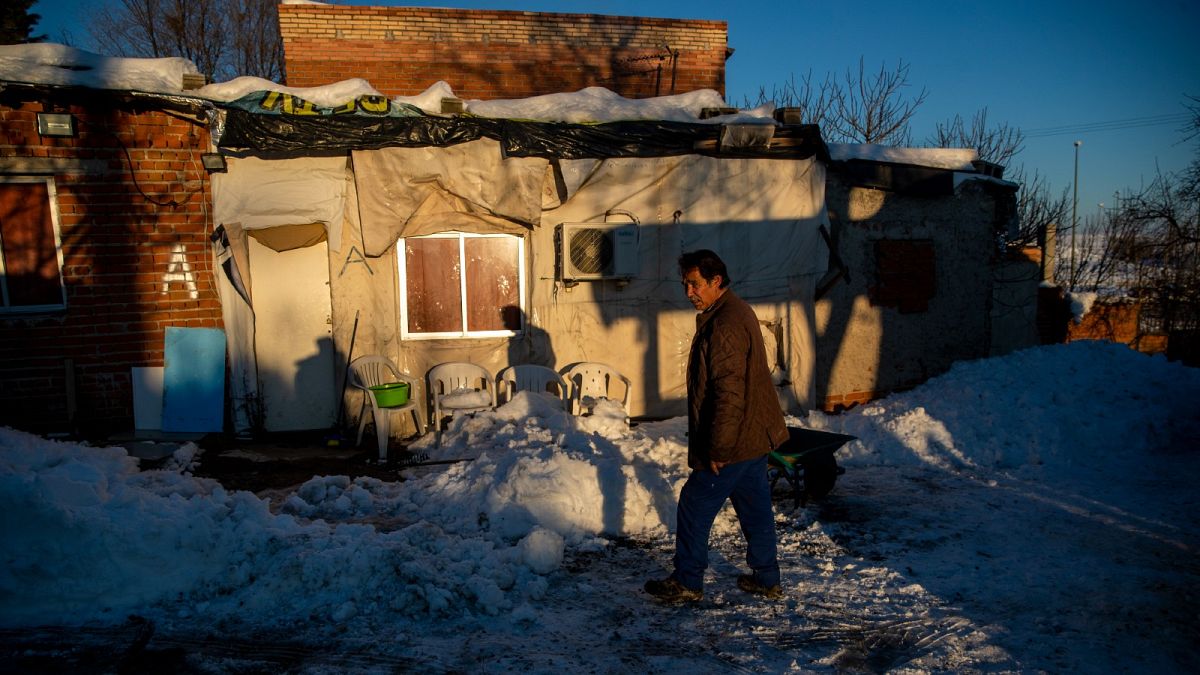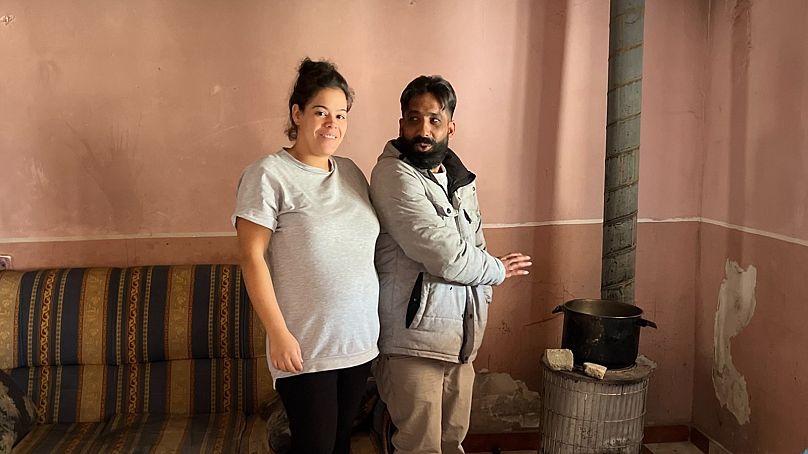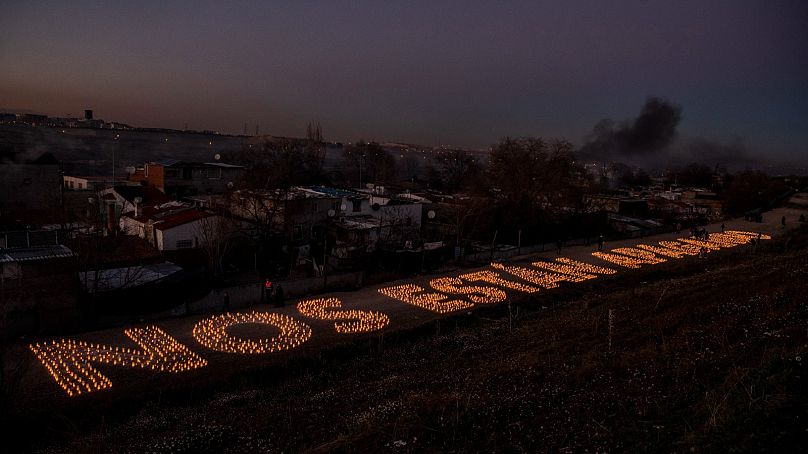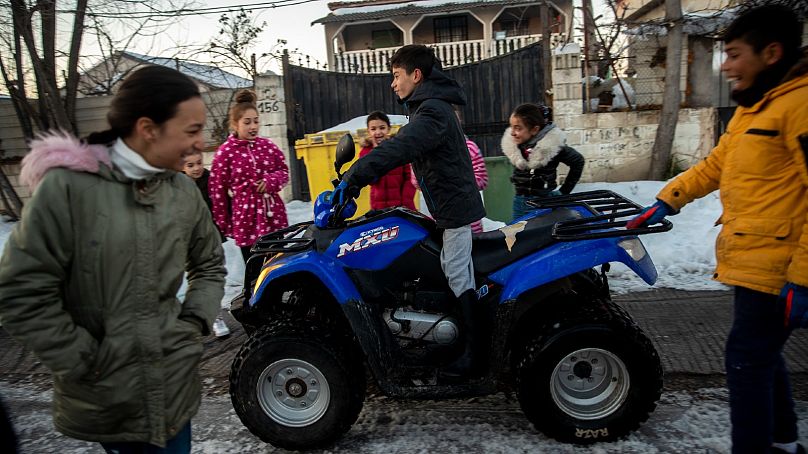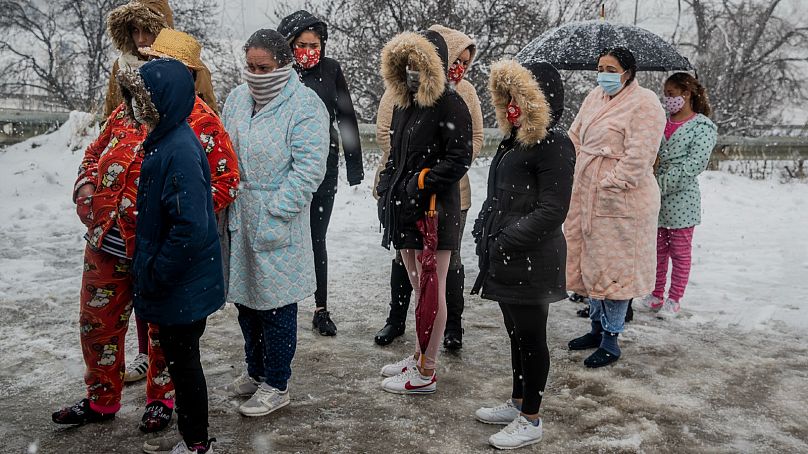The mishmash of shacks and brick and mortar just 15 kilometres from Madrid has been left in the dark since 2 October 2020.
Gemma and Angel’s house is a shell at the far end of Europe's largest shantytown where they live with their three small children.
Most of their neighbours have been rehoused or simply evicted.
They are now isolated, cut off from the rest of the Cañada Real Galiano slum by mounds of strategically placed earth, their evenings lit by candles.
“It’s already freezing in here,” said Gemma, whose wood burner and gas heater have stopped working.
The couple is expecting their fourth child next month, just as the temperatures start to drop. It’s been 760 days since they were able to siphon electricity off the grid.
Welcome to Sector VI of the Cañada Real Galiano, the first stretch of Europe’s biggest shantytown to be cleared of inhabitants.
A thousand people – 200 families – have gone. Around 3,000 remain.
“We don’t have the right requirements to be rehoused,” said Angel, referring to the need of providing proof of residence dating back to 2011. “But we have appealed, and they will let us know something in December.”
As winter approaches, the cold is a source of dread for the remaining inhabitants of Sector VI, at least a third of whom are children.
'Electricity is never going to return'
While many in Europe plan to turn down the thermostat to afford energy bills this winter, this mishmash of shacks and brick and mortar -- thrown up on undevelopable land just 15 kilometres from the centre of Madrid -- has been left in the dark since October 2, 2020.
“The electricity supply via cables is never going to return to Sector VI of the Cañada Real,” Markel Gorbea, the Madrid region’s commissioner for the Cañada Real Galiano, told Euronews. “It doesn’t matter how much noise they make.”
This was Gorbea’s stance two days before the EU’s Social Rights Committee urged the Spanish government to guarantee Cañada Real a source of electricity and heating by implementing immediate measures on 27 October.
On 31 October, Gorbea's response had not changed.
“No electricity should be supplied via those cables," added Gorbea. "If the European Committee wants to take responsibility in the event of fire then that’s up to them. In any case, it’s the central government that has to respond.”
The EU’s intervention is not the first of its kind. Last, year, the United Nations also warned the Spanish government that it was inhumane to leave people without a source of electricity.
But few expect there to be a U-turn now.
“No one has cut the electricity supply,” Gorbea insisted. “In March 2020, at the time of the pandemic, the amount of electricity being siphoned off the grid soared. Between March and October, the system on most of the Cañada collapsed. Nobody anywhere took a decision to cut the supply.”
'The place is a circus at weekends'
Doubling as Europe’s biggest drug supermarket, there are 140 narco plots or marijuana plantations on around two kilometres of Sector VI's 6.6-kilometre length. There are also 40 power voltage transformers, according to Gorbea, many of which are still supplying the narco plots with electricity.
“I don’t understand it properly,” said Gorbea. “But the drug zone is still able to connect.”
Gorbea claims that before the mafias moved in, the illegal demands on the grid were insignificant enough to turn a blind eye.
“Now the amount tapped is enough to power six industrial estates.”
According to Moroccan activist and a Sector VI resident, Houda Akrikez, power supply current limiter circuits have been installed.
While the utility company Naturgy did not comment on whether this was true, they did tell Euronews they “have been trying to reconnect the families uninterruptedly but without success".
Naturgy wants to show solidarity with the families of the Cañada Real,” but, added, if they want their electricity back, they would have to “meet the legal requirements” which would involve not living on undevelopable land and having a bona fide deed or rent agreement to their homes.
“If Naturgy feels so much solidarity with us, why don’t they agree to sit down and talk, which so far they have refused to do,” said Houda.
The marijuana is grown here but sold elsewhere. On the Cañada, the market is Class A narcotics, with heroin a top-selling product. The points of sale are marked by flaming oil drums, manned by addicts or fierce-looking Roma women.
“At the weekends, this place is a circus,” said Gorbea. “Every Tom, Dick and Harry from Madrid is down here getting their weekend supply of drugs.”
'Cañada Real is my idea of hell'
Gorbea calls the Cañada Real “a black hole.”
Quite literally, but he is, in fact, referring to the cost of resolving what is a very complex situation, one that has been left to fester far too long.
Exacerbating his headache are the demands of the remaining inhabitants in Sector VI of this old livestock route for their illegal electricity supply to be restored.
“They should give us contracts, it could be 10 years or more before we are all rehoused,” said Houda, who maintains that she has a right to her home under Spanish law, having lived there for more than 10 years without being asked to leave.
A couple of trips down to the Cañada on the southeast fringes of Madrid and you wonder why anyone would want to fight for a corner of this urban eyesore.
Strewn with junk, plagued with rats, milling with junkies and engulfed in darkness each night and you have what Conrado Gimenez -- president of the Madrina Foundation, which delivers fuel and other basic supplies to some of the worst off in the slum -- described to Euronews as “my idea of hell”.
Sector VI was converted into a drug bazaar some 10 years ago, after other notorious shantytowns around Madrid were dismantled by the authorities, such as Las Barranquillas in the south of the capital. It is said that the police are happy for the drug trade to exist, if not flourish, here.
“I’ve never seen anyone arrested in this part of the Cañada,” said Gimenez. “The police don’t dare.”
Asked why the police don’t seize the marijuana and allow the rest of the population in Sector VI to have a connection, albeit illegal, Gorbea said: “It’s not that easy. They put minors at the gates of their narco plots and, because of the way Spanish law works, that makes it complicated for the police to enter.”
But this is dismissed by Gimenez.
“I’ve certainly never seen any minors posted at gates and I know where a number of the plots are,” he said.
Nowadays, the Cañada is well and truly stigmatised. Some say this is a deliberate ploy by the authorities.
“They want them out so they can build,” Maria Lopez, from the Cañada Real Electricity Platform, told Euronews. “It’s obvious. You can see the cranes getting closer.”
Gorbea, however, insisted that this is not the case.
“Impossible,” he said. “Anyone who says we are knocking down existing homes to build on the Cañada is lying. We’re clearing them because they’re illegal.”
'It's wrapped up with my identity'
The Cañada has become synonymous with conflict. But it wasn’t always so. The 14.383 km slice of a rustic track that runs in its entirety between La Rioja and Ciudad Real was settled on as far back as the 1970s by Spaniards coming north for work.
In the 1990s, families like that of Houda Akrikez, 35, began to trickle in.
“We were amongst the first Moroccans in Sector VI,” she said, referring to the Cañada’s last and longest section.
Asked what it is about the Cañada that makes her want to stay, she told Euronews,
“The Cañada is wrapped up with my identity," she told Euronews, asked what it is about the Cañada that makes her want to stay.
"I came here when I was nine and watched my father put everything he had into building our home. The police watched as my father trucked in sand and materials and did nothing to stop him.”
Houda lives with her two daughters in one of the apartments giving on to a yard in the family compound. Her brother and sister and parents also live here.
Anywhere else, a set-up like this -- 15 km from the centre of Madrid -- would cost close to a million euros. Still, it must be a tricky place to raise children, many of whom can be seen playing between junk and junkies on the sides of the road.
“My daughters manage to get about alright and see their friends. They study hard. And they are activists,” Houda countered. “They want to show that the people on the Cañada are the future of this country.”
Demolition is still some way off for Houda’s family compound. But the stragglers, like Gemma and Angel, at the far end of Sector VI, live in constant fear of the bulldozers circling like vultures close by.
“They’re pulling down houses now without even checking if someone’s inside," claimed Juan, who built his home here in 1985 and says he has paid property tax on it for 25 years,
"You go shopping and when you get home, your house has been reduced to rubble.
"A neighbour went to Morocco to visit his sick mother and when he got back, his house and motorbike were destroyed. I’m scared the same thing will happen to me.
"I don’t want to be rehoused in a rented flat. Either they give me the deeds to a house somewhere else or they pay me compensation.
"I have sunk over €100,000 into my house here.”
One hundred metres up the Cañada, Fatima and Said are also worried sick. In constant motion, the machines have deposited a sizeable mound of earth right next to the wall of their home.
“What will happen when it rains?” Said asked, clearly beside himself. “It feels like we’re being buried alive.”
The couple has a four-year-old son who no longer goes to school due to the road being blocked. Fatima has also stopped going to the Spanish classes given by an NGO further up the Cañada.
“I cleared the road so we could get through and they just blocked it again,” Said explained.
According to Said, their application to be rehoused has been rejected on the grounds that he failed to sign the papers, despite the fact his wife Fatima did.
Gorbea, however, has a different version of events.
He told Euronews that Said had become violent with the civil servants, demanding compensation and that Fatima was only applying to be rehoused now.
“If they are determined to sit tight, there’ll be a lot of things they’ll have to put up with," said Gorbea, asked about the mountains of earth near where Said and Fatima live. "We could have done worse, but we don’t want to be inhumane.”
